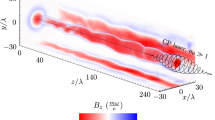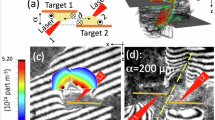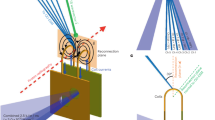Abstract
The onset and evolution of magnetic fields in laboratory and astrophysical plasmas is determined by several mechanisms1, including instabilities2,3, dynamo effects4,5 and ultrahigh-energy particle flows through gas, plasma6,7 and interstellar media8,9. These processes are relevant over a wide range of conditions, from cosmic ray acceleration and gamma ray bursts to nuclear fusion in stars. The disparate temporal and spatial scales where each process operates can be reconciled by scaling parameters that enable one to emulate astrophysical conditions in the laboratory. Here we unveil a new mechanism by which the flow of ultra-energetic particles in a laser-wakefield accelerator strongly magnetizes the boundary between plasma and non-ionized gas. We demonstrate, from time-resolved large-scale magnetic-field measurements and full-scale particle-in-cell simulations, the generation of strong magnetic fields up to 10–100 tesla (corresponding to nT in astrophysical conditions). These results open new paths for the exploration and modelling of ultrahigh-energy particle-driven magnetic-field generation in the laboratory.
This is a preview of subscription content, access via your institution
Access options
Subscribe to this journal
Receive 12 print issues and online access
$259.00 per year
only $21.58 per issue
Buy this article
- Purchase on SpringerLink
- Instant access to full article PDF
Prices may be subject to local taxes which are calculated during checkout




Similar content being viewed by others
References
Kulsrud, R. & Zweibel, E. B. On the origin of cosmic magnetic fields. Rep. Prog. Phys. 71, 046901 (2008).
Medvedev, M. V. & Loeb, A. Generation of magnetic fields in the relativistic shock of γ-ray burst sources. Astrophys. J. 526, 697–706 (1999).
Silva, L. O. et al. Interpenetrating plasma shells: Near-equipartition magnetic field generation and nonthermal particle acceleration. Astrophys. J. Lett. 596, L121 (2003).
Brandenburg, A., Sokoloff, D. & Subramanian, K. Current status of turbulent dynamo theory. Space Sci. Rev. 169, 123–157 (2012).
Kulsrud, S. W. & Anderson, R. M. The spectrum of random magnetic fields in the mean field dynamo theory of the Galactic magnetic field. Astrophys. J. 396, 606–630 (1992).
Robinson, A. P. L. & Sherlock, M. Magnetic collimation of fast electrons produced by ultraintense laser irradiation by structuring the target composition. Phys. Plasmas 14, 083105 (2007).
Bell, A. R. & Kingham, R. J. Resistive collimation of electron beams in laser-produced plasmas. Phys. Rev. Lett. 91, 035003 (2003).
Miniati, F. & Bell, A. R. Resistive magnetic field generation at Cosmic Dawn. Astrophys. J. 729, 73 (2011).
Gregori, G. et al. Generation of scaled protogalactic seed magnetic fields in laser-produced shock waves. Nature 481, 480–483 (2012).
Hillas, A. M. The origin of ultra-high-energy cosmic rays. Ann. Rev. Astron. Astrophys. 22, 425–444 (1984).
Spitkovsky, A. Particle acceleration in relativistic collisionless shocks: Fermi process at last? Astrophys. J. Lett. 682, L5 (2008).
Martins, S. F., Fonseca, R. A., Silva, L. O. & Mori, W. B. Ion dynamics and acceleration in relativistic shocks. Astrophys. J. Lett. 695, L189 (2009).
Fermi, E. On the origin of the cosmic radiation. Phys. Rev. 75, 1169–1174 (1949).
Gunn, J. E. & Ostriker, J. P. Acceleration of high-energy cosmic rays by pulsars. Phys. Rev. Lett. 22, 728–731 (1969).
Fiuza, F., Fonseca, R. A., Tonge, J., Mori, W. B. & Silva, L. O. Weibel-instability-mediated collisionless shocks in the laboratory with ultraintense lasers. Phys. Rev. Lett. 108, 235004 (2012).
Rosenzweig, J. B. Trapping, thermal effects, and wave breaking in the nonlinear plasma wake-field accelerator. Phys. Rev. A 38, 3634–3642 (1988).
Chen, P., Tajima, T. & Takahashi, Y. Plasma wakefield acceleration for ultrahigh-energy cosmic rays. Phys. Rev. Lett. 89, 161101 (2002).
Chang, F-Y., Chen, P., Lin, G-L., Noble, R. & Sydora, R. Magnetowave induced plasma wakefield acceleration for ultrahigh energy cosmic rays. Phys. Rev. Lett. 102, 111101 (2009).
Malka, V. et al. Electron acceleration by a wake field forced by an intense ultrashort laser pulse. Science 298, 1596–1600 (2002).
Modena, A. et al. Electron acceleration from the breaking of relativistic plasma waves. Nature 377, 606–608 (1995).
Walton, B. et al. Measurements of magnetic field generation at ionization fronts from laser wakefield acceleration experiments. New J. Phys. 15, 025034 (2013).
Sylla, F., Veltcheva, M., Kahaly, S., Flacco, A. & Malka, V. Development and characterization of very dense submillimetric gas jets for laser-plasma interaction. Rev. Sci. Instrum. 83, 033507 (2012).
Lifschitz, A. et al. Ion acceleration in underdense plasmas by ultra-short laser pulses. New J. Phys. 16, 033031 (2014).
Sun, G-Z., Ott, E., Lee, Y. C. & Guzdar, P. Self-focusing of short intense pulses in plasmas. Phys. Fluids 30, 526–532 (1987).
Fonseca, R. A. et al. Osiris: A three-dimensional, fully relativistic particle in cell code for modeling plasma based accelerators. Lecture Notes Computer Sci. 2331, 342–351 (2002).
Fonseca, R. A. et al. One-to-one direct modeling of experiments and astrophysical scenarios: Pushing the envelope on kinetic plasma simulations. Plasma Phys. Control. Fusion 50, 124034 (2008).
Esirkepov, T. Zh., Kato, Y. & Bulanov, S. V. Bow wave from ultraintense electromagnetic pulses in plasmas. Phys. Rev. Lett. 101, 265001 (2008).
Kronberg, P. P. Extragalactic magnetic fields. Rep. Prog. Phys. 57(4), 325–382 (1994).
Buck, A. et al. Real-time observation of laser-driven electron acceleration. Nature Phys. 7, 1745–2473 (2011).
Flacco, A., Rax, J-M. & Malka, V. Reconstruction of polar magnetic field from single axis tomography of Faraday rotation in plasmas. Phys. Plasmas 19, 103107 (2012).
Acknowledgements
The authors acknowledge the support of OSEO project n.I0901001W-SAPHIR, the support of the European Research Council through the PARIS ERC project (contract 226424) and the national research grants BLAN08-1-380251 (GOSPEL) and IS04-002-01 (ILA). A.F. acknowledges collaboration with T. Vinci (LULI, École Polytechnique). The work of J.V. and L.O.S. is partially supported by the European Research Council through the Accelerates ERC project (contract ERC-2010-AdG-267841) and by FCT, Portugal (contract EXPL/FIZ-PLA/0834/1012). We acknowledge PRACE for access to resources on SuperMUC (Leibniz Research Center).
Author information
Authors and Affiliations
Contributions
S.K., F.S., M.V. and A.F. conceived, designed and carried out the experimental measurements, A.F. conceived, designed and realized the analysis tools and performed the data analysis, A.L., J.V. and L.O.S. carried out the numerical simulations, A.F., J.V. and L.O.S. wrote the manuscript, V.M. provided overall supervision.
Corresponding author
Ethics declarations
Competing interests
The authors declare no competing financial interests.
Rights and permissions
About this article
Cite this article
Flacco, A., Vieira, J., Lifschitz, A. et al. Persistence of magnetic field driven by relativistic electrons in a plasma. Nature Phys 11, 409–413 (2015). https://doi.org/10.1038/nphys3303
Received:
Accepted:
Published:
Issue date:
DOI: https://doi.org/10.1038/nphys3303
This article is cited by
-
Characterisation and Modelling of Ultrashort Laser-Driven Electromagnetic Pulses
Scientific Reports (2020)
-
Three electron beams from a laser-plasma wakefield accelerator and the energy apportioning question
Scientific Reports (2017)
-
Detailed Experimental Study of Ion Acceleration by Interaction of an Ultra-Short Intense Laser with an Underdense Plasma
Scientific Reports (2016)



